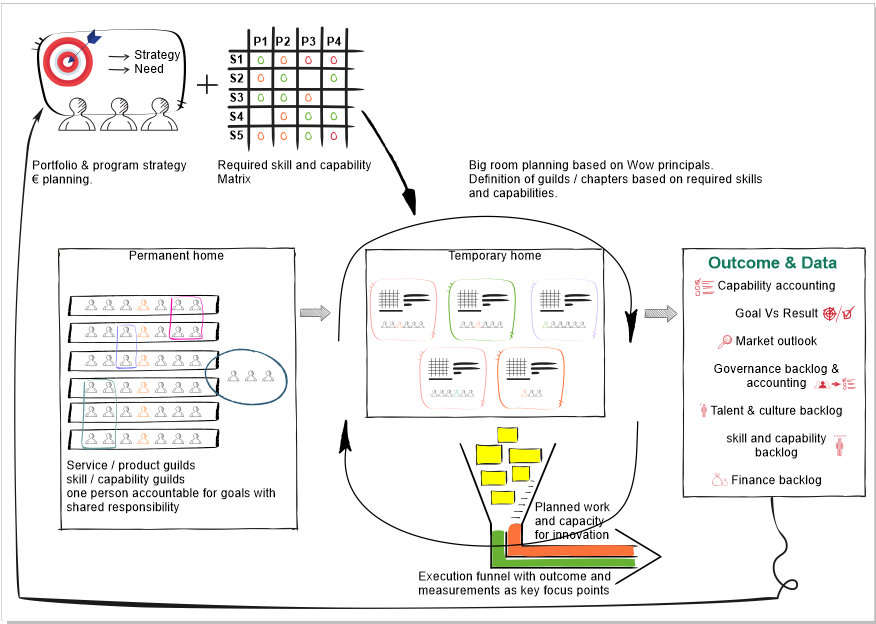KNOM Element Three, Producing Results Incrementally and Iteratively: Part 4


SAKET BIVALKAR
Business Coach
“The effective execution of a plan is what counts and not mere planning on paper.”
– Spoken by J.R.D. Tata at The Central Advisory Council of Industries, New Delhi, August 13, 1965
In part 3 of this article series, Element 2: Strategy Formation & Program Development, we covered that strategy is continuous learning from insights gathered throughout the Kownedlge Network Operating Model (KNOM) structure. A guideline that further connects with the larger aims of the KNOM framework of adaptability rather than rigidity and that value is centred on the people within the organisation.

In a nutshell, Element 3: Big Room Planning & Temporary Home is the execution of the organisation’s strategies and plans. It is where new products and services spring to life or crucial iterations on existing products/services. However, Element 3 is not a department in stasis. Projects are executed with the dynamism the KNOM structure is founded upon.
In greater detail, we will have to break down Element 3 into its two constituent parts.
First Part: Big Room Planning
Element 3 is a space dedicated to showing projects designed in Element 2: Strategy Formation & Planning. These projects are all outlined based on five dimensions: financial, legal, technical, social, and operational. Further, each project is either an improvement of an existing product or service or an entirely new innovation. For the initiatives to be executed and made operational, a Skills Matrix is attached delineating which skills and competencies must be fulfilled to bring the project to fruition.
Once the initiative is presented in the big room and risk mitigation is explained, people from all areas of the organisation are explained based on skill matrix, people choose on which initiative they want to spend their time on during the next iteration. Which leads us the temporary home.
Analogously, Big Room Planning is akin to when high school clubs look for new members having students walk up to a shared board and sign themselves up for a tryout.
In operational management terminology, Big Room Planning takes the insights and advantages from the event concept: Open Space Technology.
Open Space Technology is a participant-driven venue as opposed to organiser-driven. It means the Big Room Planning has a loose structure with the people shaping dynamically how the Big Room Planning evolves. This promotes agility and freedom for an organisation’s people to perform their best with no stringent oversight, leading us to the next part.
Second Part: Temporary Home
Each Big Room Planning event and subsequent initiatives listed have a time horizon of two to three months. This means the people are temporarily connected with an initiative during its 2-3 months duration.
The reason for this fluctuation is to promote a continuous process of learning and whole-scale change supported by WoW principles.
WoW stands for ‘Way of Working’ and refers to agility and adaptability in producing results incrementally and iteratively. Practically, this can transform into the organisation adopting a Disciplined Agile approach, Large-Scale Scrum (LeSS) or any number of Way of Working principles supported by whole-scale change. The details are less important rather than the overarching structure of Element 3.
Furthermore, to promote continuous learning and the formation of a knowledge network, dynamic reteaming is put front and centre.
Dynamic reteaming, as described in the seminal book: “Dynamic Reteaming: The Art & Wisdom of Changing Teams” by Heidi Helfand is a continuous process of moving people and knowledge around the organisation in ever-changing teams.
Thus, avoiding the degradation of teams over time while taking advantage of the creative synergies, shared goals and ownership of outcomes inherent in functional teams. Lastly, further promoting up- and reskilling while fostering employee freedom, leading to improved motivation and job performance.
Ultimately, dynamic reteaming is tapping into the core value of an organisation and what the KNOM structure is founded on: its people.
In short, Element 3: Big Room Planning & Temporary Home is where the execution of the plan is performed by ever-changing and dynamic teams. Thus, Element 3 is a people-driven process creating value and sending the operational initiatives projects to the next Element 4: Execution Pipeline.
This is also where organisations learn the structures or designs and adjust just like we said we learn the strategy.
Realising your Strategy: The Critical Role of Operating Models
Organizations must continuously adapt and evolve to stay ahead of the competition. One key factor in achieving realisation of strategy is the operating model, which serves as the foundation for execution and provides a clear guide for how resources are organised to get critical work done.
Learning to Change: How Organizational Learning Fuels Transformation
From the importance of leadership support to leveraging technology for accessible learning, we cover the essential elements that make learning the heartbeat of organizational transformation.
Harnessing the Power of Management Innovation
Discover the transformative power of management innovation with Versatile Consulting in driving business success. Lets innovative management practices that can create a competitive edge, foster a culture of innovation, and navigate the challenges of today’s dynamic business environment.



